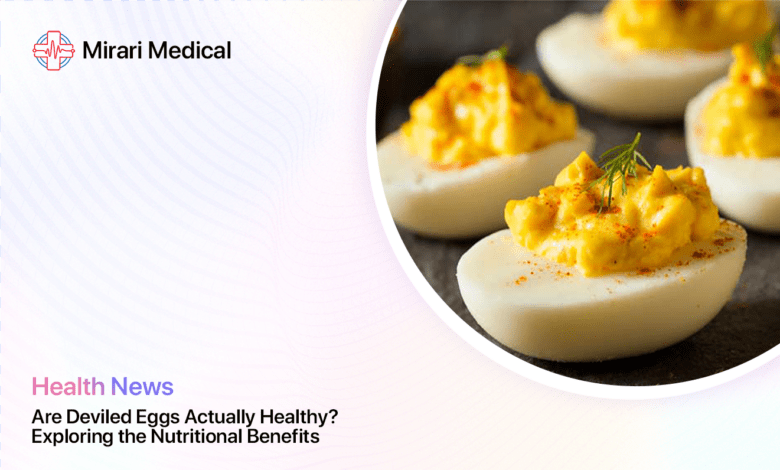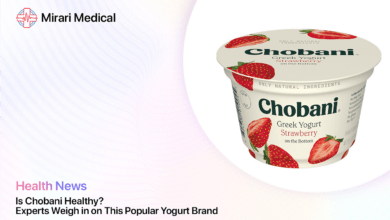Are Deviled Eggs Actually Healthy? Exploring the Nutritional Benefits

You may be interested
Did you know that the average American eats around 250 eggs per year?[1] That’s a lot of omelets, scrambles, and of course, deviled eggs! These tasty little appetizers are a staple at parties, picnics, and potlucks. But have you ever stopped to wonder – are deviled eggs actually good for you? Let’s crack open the nutritional facts and find out.
Deviled eggs have been around since ancient Roman times, when they were served as a starter at fancy banquets. The term “deviled” didn’t come about until the 18th century, when it was used to describe highly seasoned or spicy foods.[2] Today, deviled eggs are known for their creamy, tangy filling and fun garnishes like paprika or bacon bits.
But beyond their delicious taste, deviled eggs also pack a nutritional punch. One large egg contains 6 grams of high-quality protein, plus essential vitamins and minerals like vitamin D, choline, and selenium.[3] However, eggs are also notorious for their cholesterol content, which has raised concerns about heart health in the past.
So what’s the verdict – are deviled eggs a healthy snack or an indulgence to enjoy in moderation? In this article, we’ll explore the nutritional benefits and potential drawbacks of this classic appetizer. We’ll also share some tips for making your deviled eggs even healthier and discuss tasty alternatives to the traditional recipe. By the end, you’ll have all the facts you need to decide whether deviled eggs deserve a spot on your plate. Let’s dig in!
What Are Deviled Eggs?
Before we get into the nitty-gritty of nutrition, let’s start with the basics. What exactly are deviled eggs, anyway?
At their core, deviled eggs are simply hard-boiled eggs that have been cut in half and stuffed with a creamy filling. The egg yolks are removed, mashed up with other ingredients like mayonnaise, mustard, and seasonings, then piped or spooned back into the egg white halves.
The specific ingredients and ratios can vary depending on the recipe, but most deviled eggs contain some combination of:
- Hard-boiled egg yolks
- Mayonnaise or Greek yogurt
- Mustard (usually Dijon or yellow)
- Vinegar or lemon juice
- Salt and pepper
- Paprika or other spices for garnish
Some recipes get creative with add-ins like bacon, avocado, sriracha, or pickles. Others keep it classic with just the basic ingredients. No matter how you devil your eggs, the end result is a bite-sized appetizer that’s creamy, tangy, and satisfying.
Deviled eggs are often associated with summer picnics, Easter brunch, and retro dinner parties. But they’re also a popular snack or light meal year-round. You can find pre-made deviled eggs at many grocery stores and delis, or whip up a batch at home in about 30 minutes.
One of the great things about deviled eggs is their versatility. They can be customized to suit any taste preference or dietary need. Don’t like mayonnaise? Swap in Greek yogurt or mashed avocado. Watching your sodium intake? Cut back on the salt and amp up the herbs and spices. The possibilities are endless!
Now that we’ve covered the basics of what deviled eggs are, let’s take a closer look at how they’re made.
How Are Deviled Eggs Made?
Making deviled eggs is a fairly simple process that requires just a few basic kitchen skills. Here’s a step-by-step breakdown:
- Hard boil the eggs: Start by placing your eggs in a saucepan and covering them with cold water. Bring the water to a boil over high heat, then remove the pan from the heat, cover it, and let the eggs sit in the hot water for 10-12 minutes. This allows the eggs to cook through without getting rubbery.
- Cool and peel the eggs: Once the eggs are cooked, drain the hot water and run cold water over the eggs to stop the cooking process. Let the eggs sit in the cold water for a few minutes until they’re cool enough to handle. Then, gently tap the eggs on the counter to crack the shell all over, and peel away the shell under running water.
- Cut and scoop: Using a sharp knife, carefully cut each peeled egg in half lengthwise. Use a spoon to gently scoop out the yolk from each half, placing the yolks in a bowl. Arrange the empty egg white halves on a serving platter.
- Mash and mix: Use a fork to mash the egg yolks until they’re crumbly. Add your desired mix-ins, like mayonnaise, mustard, vinegar, salt, and pepper. Stir everything together until smooth and creamy. For an extra-smooth filling, you can use a food processor to blend the ingredients.
- Fill and garnish: Spoon or pipe the yolk mixture into the egg white halves, filling the cavity where the yolk used to be. Sprinkle with paprika, chopped chives, or other garnishes as desired.
- Chill and serve: For best results, cover the deviled eggs and refrigerate for at least 30 minutes before serving. This allows the flavors to meld and the filling to firm up slightly. Deviled eggs are best enjoyed cold, so keep them refrigerated until ready to serve.
Some recipes may call for additional steps or ingredients, but this is the basic process for making classic deviled eggs. With a little practice, you can have a platter of these tasty bites ready in no time!
A few tips to keep in mind:
- Older eggs are actually easier to peel than fresh ones. If possible, use eggs that are about a week old for the best results.
- To prevent the egg white halves from wobbling on your serving tray, slice a thin strip off the bottom of each half to create a flat base.
- If you’re making deviled eggs for a crowd, you can prepare the components ahead of time. Boil and peel the eggs up to 2 days in advance, and make the filling up to 1 day ahead. Store separately in the fridge, then fill and garnish just before serving.
- For a fancier presentation, use a piping bag fitted with a star tip to pipe the filling into the egg whites. You can also get creative with your garnishes, making designs or patterns on top of the filling.
Now that you know how deviled eggs are made, let’s talk about what makes them a nutritious (and delicious) choice.
What Are the Nutritional Benefits of Deviled Eggs?
Eggs are often touted as a nutritional powerhouse, and for good reason. These little packages are loaded with essential vitamins, minerals, and high-quality protein that our bodies need to thrive. Let’s break down some of the key nutritional benefits of deviled eggs.
1. High in Protein
One of the biggest advantages of eggs is their protein content. A single large egg contains about 6 grams of protein, making it an excellent choice for building and repairing muscle tissue, keeping you feeling full and satisfied, and supporting healthy immune function.[4]
The protein in eggs is also highly bioavailable, meaning our bodies can easily digest and absorb it. In fact, eggs are often used as the standard for measuring the protein quality of other foods.[5]
When you make deviled eggs, you’re essentially concentrating the protein from the egg yolks into a small, bite-sized package. Depending on the recipe, one or two deviled egg halves can pack as much protein as a small chicken breast or a cup of lentils.
This makes deviled eggs an excellent snack option for athletes, seniors, and anyone looking to boost their protein intake in a tasty way. Just be mindful of the other ingredients in your recipe, like mayonnaise or cheese, which can add extra fat and calories.
2. Good Source of Healthy Fats
Eggs are also a good source of healthy fats, particularly in the yolk. While the egg white is mostly protein and water, the yolk contains a mix of saturated, monounsaturated, and polyunsaturated fats, including omega-3 fatty acids.[6]
Omega-3s are a type of essential fat that our bodies can’t produce on their own, so we need to get them from food sources. They play important roles in brain development, heart health, and reducing inflammation throughout the body.[7]
One large egg yolk contains about 70 milligrams of omega-3s, mostly in the form of DHA (docosahexaenoic acid).[8] While this is less than you’d get from fatty fish like salmon or sardines, it’s still a significant amount for a small food like an egg.
The monounsaturated and polyunsaturated fats in egg yolks can also help improve cholesterol levels by raising “good” HDL cholesterol and lowering “bad” LDL cholesterol.[9] This is important for heart health and reducing the risk of chronic diseases like diabetes and certain cancers.
Of course, it’s important to note that deviled eggs often contain added fats from ingredients like mayonnaise or sour cream. Choosing a recipe that uses Greek yogurt or mashed avocado in place of mayo can help keep the fat content in check while still providing those beneficial yolk fats.
3. Rich in Vitamins and Minerals
In addition to protein and healthy fats, eggs are packed with essential vitamins and minerals that support overall health. Some of the key nutrients found in eggs include:
- Vitamin D: Eggs are one of the few natural food sources of vitamin D, which is important for bone health, immune function, and regulating mood. One large egg contains about 10% of the daily value for vitamin D.[10]
- Choline: Egg yolks are an excellent source of choline, an essential nutrient that plays a role in brain development, liver function, and metabolism. One large egg contains about 35% of the daily value for choline.[11]
- Vitamin B12: Eggs are a good source of vitamin B12, which is important for red blood cell formation, neurological function, and DNA synthesis. One large egg contains about 20% of the daily value for B12.[12]
- Selenium: This mineral acts as an antioxidant in the body, helping to protect cells from damage and supporting immune function. One large egg contains about 28% of the daily value for selenium.[13]
- Lutein and Zeaxanthin: These antioxidants are concentrated in the yolk and help protect eye health by filtering out harmful blue light and reducing the risk of age-related vision loss. One large egg contains about 250 micrograms of lutein and zeaxanthin combined.[14]
While the exact nutrient content of deviled eggs will vary depending on the recipe and serving size, incorporating eggs into your diet is a tasty way to boost your intake of these important vitamins and minerals. Just be sure to enjoy them as part of a balanced diet that also includes plenty of colorful fruits and veggies, whole grains, and lean proteins.
4. Low in Calories
Compared to other appetizers and snack foods, deviled eggs are relatively low in calories. One classic deviled egg half (made with mayo) contains about 70-80 calories, depending on the recipe.[15]
This means you can enjoy a few deviled eggs as a satisfying snack or appetizer without totally blowing your calorie budget for the day. Of course, the calorie content can quickly add up if you’re using high-fat ingredients like bacon, cheese, or lots of mayo in your recipe.
To keep your deviled eggs on the lighter side, try using Greek yogurt or mashed avocado in place of some or all of the mayonnaise. You can also load up on low-calorie garnishes like herbs, spices, and chopped veggies to add flavor and nutrition without a lot of extra calories.
Another benefit of deviled eggs being low in calories is that they can be a good choice for people trying to lose weight or maintain a healthy weight. The protein and fat in the eggs can help keep you feeling full and satisfied, which may reduce overall calorie intake and promote weight loss over time.[16]
Of course, deviled eggs are not a magic bullet for weight loss, and they should be enjoyed as part of a balanced diet that includes a variety of nutrient-dense foods. But if you’re looking for a tasty and filling snack that won’t derail your diet, deviled eggs can be a smart choice.
Are There Any Potential Health Risks of Eating Deviled Eggs?
While deviled eggs can be a nutritious addition to your diet, there are a few potential health concerns to keep in mind. Let’s take a closer look at the two main risks associated with eating deviled eggs.
1. High in Cholesterol
One of the biggest concerns people have about eggs is their cholesterol content. A single large egg contains about 185 milligrams of cholesterol, all of which is found in the yolk.[17] This is more than half of the daily recommended limit of 300 milligrams for healthy adults.
For many years, experts believed that dietary cholesterol (the kind found in food) was a major contributor to high blood cholesterol levels and heart disease risk. As a result, people with high cholesterol were often advised to limit their egg intake or avoid the yolks altogether.
However, more recent research has shown that dietary cholesterol actually has a relatively small impact on blood cholesterol levels for most people.[18] In fact, studies have found that eating up to three eggs per day does not significantly increase the risk of heart disease in healthy people.[19]
That being said, some people are more sensitive to dietary cholesterol than others. For example, people with diabetes or a genetic condition called familial hypercholesterolemia may see a bigger spike in blood cholesterol levels after eating eggs or other high-cholesterol foods.[20]
If you have a history of high cholesterol or are at increased risk for heart disease, talk to your doctor or a registered dietitian about how many eggs are safe for you to eat. You may need to limit your intake or choose lower-cholesterol recipes for your deviled eggs, like using only egg whites or subbing in tofu for some of the yolks.
2. Potential for Food Poisoning
Another potential risk of eating deviled eggs is food poisoning, particularly from a type of bacteria called Salmonella. Eggs can sometimes be contaminated with Salmonella on the inside or outside of the shell, and if they’re not cooked properly, the bacteria can make you sick.
Symptoms of Salmonella poisoning include diarrhea, fever, and stomach cramps, which usually develop within 12-72 hours after eating contaminated food.[21] While most people recover on their own within a few days, some may need hospitalization for severe dehydration or other complications.
To reduce your risk of Salmonella poisoning from deviled eggs, follow these food safety tips:
- Use fresh, clean, uncracked eggs and wash your hands before handling them.
- Cook the eggs until both the whites and yolks are firm. Avoid recipes that call for raw or undercooked eggs.
- Keep the cooked eggs refrigerated until ready to assemble the deviled eggs. Don’t leave them at room temperature for more than 2 hours.
- Use clean utensils and cutting boards to prepare the deviled eggs, and wash your hands thoroughly after handling the egg shells.
- Store leftover deviled eggs in the refrigerator and eat within 3-4 days. Toss any eggs that have been left out at room temperature for more than 2 hours.
By following these simple food safety guidelines, you can enjoy deviled eggs without worrying about getting sick. If you’re serving deviled eggs at a party or potluck, consider keeping them on ice or in a cooler to maintain a safe temperature.
It’s also worth noting that some people may be allergic to eggs or other ingredients commonly used in deviled egg recipes, like mustard or paprika. If you have a known food allergy, be sure to read labels carefully and avoid any recipes that contain your trigger foods.
How Can You Make Deviled Eggs Healthier?
If you love deviled eggs but want to make them a bit healthier, there are plenty of simple swaps and tweaks you can make to your favorite recipes. Here are some ideas to try:
1. Swap Out Ingredients
One of the easiest ways to make deviled eggs healthier is to swap out some of the high-fat or high-calorie ingredients for lighter options. For example:
- Use Greek yogurt or mashed avocado in place of some or all of the mayonnaise. This adds protein, healthy fats, and creaminess without as much saturated fat or calories.
- Replace half of the egg yolks with mashed chickpeas or silken tofu. This cuts down on cholesterol while adding fiber and plant-based protein.
- Swap out the salt for herbs, spices, or lemon juice to add flavor without extra sodium. Try using smoked paprika, dill, curry powder, or sriracha for a kick.
- Use low-fat or fat-free mayonnaise or sour cream in place of the full-fat versions. Just be aware that these products may contain added sugars or fillers to compensate for the lack of fat.
By making these simple substitutions, you can create a deviled egg that’s just as delicious but with a healthier nutritional profile. Don’t be afraid to experiment with different ingredients and flavor combinations to find your perfect recipe!
2. Use Healthier Cooking Methods
Another way to make deviled eggs healthier is to use cooking methods that reduce fat and calories. For example:
- Instead of boiling the eggs, try steaming them. This can help prevent the yolks from getting overcooked and rubbery, which can make them harder to mash and mix smoothly.
- Use a cooking spray or brush the egg white halves with a small amount of olive oil before filling them. This adds healthy fats and prevents the filling from sticking to the whites.
- Bake the assembled deviled eggs in the oven for a few minutes to warm them through and melt any cheese on top. This can help reduce the amount of mayonnaise or other high-fat ingredients needed for creaminess.
By using these healthier cooking techniques, you can create deviled eggs that are just as tasty but with fewer calories and less fat. Plus, you may discover new flavor combinations or textures that you love!
3. Portion Control
Finally, one of the simplest ways to make deviled eggs healthier is to watch your portion sizes. While deviled eggs can be a nutritious snack or appetizer, they can also be easy to overeat, especially if you’re mindlessly munching at a party or potluck.
To keep your portions in check, try these tips:
- Use smaller eggs to make your deviled eggs, like medium or large instead of extra-large or jumbo. This will automatically reduce the calorie and fat content per serving.
- Fill the egg white halves only about 3/4 full with the yolk mixture, instead of mounding it up high. This will help you stretch the filling across more servings and prevent overeating.
- Serve deviled eggs alongside other healthy snacks, like raw veggies, fruit, or whole grain crackers. This will help fill you up with fiber and nutrients so you’re less likely to overeat the eggs.
- Take a mindful approach to eating deviled eggs, savoring each bite slowly and paying attention to your hunger and fullness cues. Stop eating when you feel satisfied, not stuffed.
By practicing portion control and mindful eating, you can enjoy deviled eggs as part of a healthy, balanced diet without going overboard. Remember, the goal is to nourish your body with delicious, nutritious foods, not to deprive yourself or feel guilty about your choices.
Are There Any Alternatives to Traditional Deviled Eggs?
If you’re looking for a twist on the classic deviled egg recipe, there are plenty of delicious and creative alternatives to try. Here are a few ideas to get you started:
1. Avocado Deviled Eggs
For a heart-healthy twist on traditional deviled eggs, try using mashed avocado in place of some or all of the mayonnaise. Avocados are rich in monounsaturated fats, fiber, and vitamins K, C, and B6, making them a nutritious addition to any recipe.[22]
To make avocado deviled eggs, simply mash the cooked egg yolks with ripe avocado, lemon juice, salt, and pepper until smooth. You can also add in other flavorings like garlic powder, cumin, or chili powder for an extra kick. Pipe or spoon the mixture into the egg white halves and garnish with chopped cilantro or a sprinkle of paprika.
2. Hummus Deviled Eggs
Another protein-packed alternative to traditional deviled eggs is to use hummus in place of the mayonnaise. Hummus is made from chickpeas, which are high in fiber, plant-based protein, and minerals like iron and folate.[23]
To make hummus deviled eggs, blend the cooked egg yolks with your favorite hummus (plain or flavored), lemon juice, and any other desired seasonings until smooth. You can also add in some chopped roasted red peppers, sun-dried tomatoes, or olives for extra flavor and texture. Pipe or spoon the mixture into the egg white halves and garnish with a sprinkle of smoked paprika or za’atar.
3. Greek Yogurt Deviled Eggs
For a tangy and protein-rich twist on classic deviled eggs, try using Greek yogurt in place of some or all of the mayonnaise. Greek yogurt is high in protein, calcium, and probiotics, which can support digestive health and boost immunity.[24]
To make Greek yogurt deviled eggs, mash the cooked egg yolks with plain Greek yogurt, Dijon mustard, lemon juice, salt, and pepper until smooth. You can also add in some chopped fresh herbs like dill, chives, or parsley for extra flavor. Pipe or spoon the mixture into the egg white halves and garnish with a sprinkle of paprika or a slice of smoked salmon.
These are just a few examples of the many delicious and creative ways you can remix the classic deviled egg recipe. Don’t be afraid to experiment with different ingredients, flavors, and toppings to find your perfect combination. The possibilities are endless!
FAQs
Is it healthy to eat deviled eggs?
Deviled eggs can be a healthy snack or appetizer when enjoyed in moderation as part of a balanced diet. They are a good source of protein, healthy fats, and essential vitamins and minerals like vitamin D, choline, and selenium. However, they can also be high in cholesterol and saturated fat depending on the recipe, so it’s important to watch your portion sizes and choose healthier ingredients when possible.
How many calories do deviled eggs have?
The calorie content of deviled eggs can vary depending on the recipe and serving size. On average, one classic deviled egg half (made with mayonnaise) contains about 70-80 calories. However, this can range from 50-100 calories or more per half depending on the ingredients used and the size of the eggs.
How many deviled eggs should one person eat?
The number of deviled eggs one person should eat depends on their individual dietary needs and goals. As a general guideline, aim to keep your portion size to 2-3 deviled egg halves per serving, or about 1/4 to 1/3 of a full recipe. This will provide a satisfying snack or appetizer without going overboard on calories or fat. If you’re watching your cholesterol intake, you may want to limit yourself to 1-2 deviled egg halves per serving or choose a lower-cholesterol recipe.
Why are deviled eggs so good?
Deviled eggs are a popular and delicious snack for many reasons. First, they have a creamy, rich texture and a savory, tangy flavor that’s hard to resist. The combination of smooth egg yolk filling and tender egg white is satisfying and filling. Second, they’re easy to customize with different ingredients and toppings to suit your taste preferences. You can make them spicy, sweet, or savory depending on your mood. Finally, they’re a fun and festive appetizer that’s perfect for parties, potlucks, and holidays. They’re easy to make ahead of time and transport, and they always look impressive on a platter.
What is so devilish about deviled eggs?
The term “deviled” in deviled eggs doesn’t actually refer to anything sinister or spicy. Instead, it’s a culinary term that dates back to the 18th century, when it was used to describe highly seasoned or spicy foods. In the case of deviled eggs, the yolk mixture is typically seasoned with mustard, vinegar, and other bold flavors that give it a tangy, zesty kick. Some recipes also include hot sauce or cayenne pepper for an extra spicy twist. So while deviled eggs may not be truly “devilish,” they do have a bit of a flavor punch that sets them apart from plain boiled eggs.
Do black people eat deviled eggs?
Yes, deviled eggs are enjoyed by people of all races and ethnicities around the world. They are a popular appetizer in many different cuisines, from American to European to Asian. In fact, deviled eggs have a long and diverse history that spans many cultures and traditions. While the exact origins of deviled eggs are unclear, similar dishes have been enjoyed for centuries in ancient Rome, medieval Europe, and the Middle East. Today, you can find countless variations on the classic deviled egg recipe, from Korean-style eggs with kimchi and gochujang to Mexican-style eggs with avocado and jalapeño. So no matter your background or taste preferences, there’s a deviled egg out there for everyone to enjoy!
Takeaways
- Deviled eggs are a nutritious snack or appetizer that can be enjoyed in moderation as part of a balanced diet. They are high in protein, healthy fats, and essential vitamins and minerals.
- To make deviled eggs healthier, try swapping out high-fat ingredients like mayonnaise for lighter options like Greek yogurt or avocado, and using herbs and spices for flavor instead of salt.
- Watch your portion sizes when eating deviled eggs, aiming for 2-3 halves per serving or about 1/4 to 1/3 of a full recipe. This will help you enjoy the flavor without going overboard on calories or fat.
- There are many delicious and creative alternatives to traditional deviled eggs, like avocado deviled eggs, hummus deviled eggs, and Greek yogurt deviled eggs. Don’t be afraid to experiment with different ingredients and flavors to find your perfect combination.
- While deviled eggs are relatively low in calories and high in nutrients, they can also be high in cholesterol and saturated fat depending on the recipe. If you have a history of high cholesterol or are at increased risk for heart disease, talk to your doctor or a registered dietitian about how many eggs are safe for you to eat.
- To reduce your risk of food poisoning from deviled eggs, be sure to use fresh, clean eggs, cook them until the yolks are firm, and keep them refrigerated until ready to serve. Avoid leaving deviled eggs at room temperature for more than 2 hours, and store leftovers in the fridge for up to 3-4 days.
With these tips and tricks in mind, you can enjoy deviled eggs as a delicious and nutritious addition to your healthy eating plan. Whether you prefer them classic or creative, spicy or savory, there’s a deviled egg recipe out there for everyone to love. So go ahead and devil up some eggs – your taste buds (and your body) will thank you!
References
- https://www.statista.com/statistics/183678/per-capita-consumption-of-eggs-in-the-us-since-2000/
- https://www.smithsonianmag.com/arts-culture/a-brief-history-of-deviled-eggs-109214379/
- https://www.healthline.com/nutrition/10-proven-health-benefits-of-eggs
- https://www.ncbi.nlm.nih.gov/pmc/articles/PMC6470839/
- https://www.ncbi.nlm.nih.gov/pubmed/22760561
- https://www.ncbi.nlm.nih.gov/pmc/articles/PMC6126094/
- https://www.ncbi.nlm.nih.gov/pubmed/29039970
- https://www.ncbi.nlm.nih.gov/pubmed/16340654
- https://www.ncbi.nlm.nih.gov/pubmed/16340654
- https://ods.od.nih.gov/factsheets/VitaminD-HealthProfessional/
- https://ods.od.nih.gov/factsheets/Choline-HealthProfessional/
- https://ods.od.nih.gov/factsheets/VitaminB12-HealthProfessional/
- https://ods.od.nih.gov/factsheets/Selenium-HealthProfessional/
- https://www.ncbi.nlm.nih.gov/pmc/articles/PMC3705341/
- https://fdc.nal.usda.gov/fdc-app.html#/food-details/172184/nutrients
- https://www.ncbi.nlm.nih.gov/pubmed/28978542
- https://www.ncbi.nlm.nih.gov/books/NBK542261/
- https://www.ncbi.nlm.nih.gov/pmc/articles/PMC6024687/
- https://www.ncbi.nlm.nih.gov/pubmed/30874756
- https://www.ncbi.nlm.nih.gov/pmc/articles/PMC2989358/
- https://www.cdc.gov/salmonella/general/index.html
- https://fdc.nal.usda.gov/fdc-app.html#/food-details/171706/nutrients
- https://fdc.nal.usda.gov/fdc-app.html#/food-details/173756/nutrients
- https://fdc.nal.usda.gov/fdc-app.html#/food-details/170886/nutrients
Your trusted source for health info, offering expert advice, news, and tips to stay healthy and informed.





